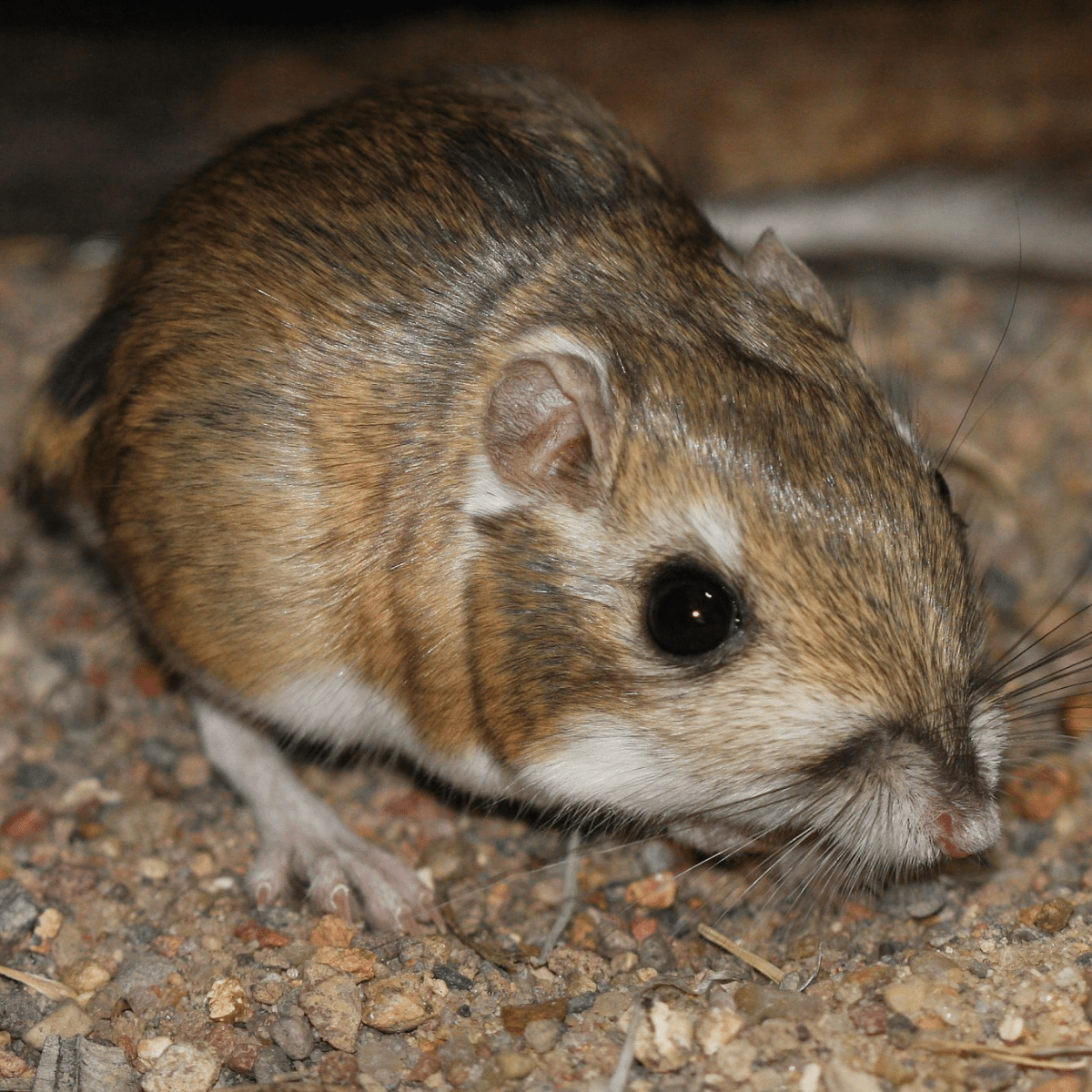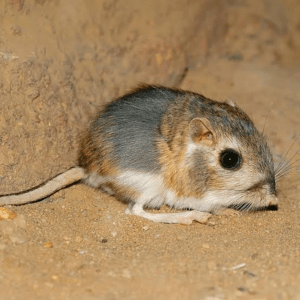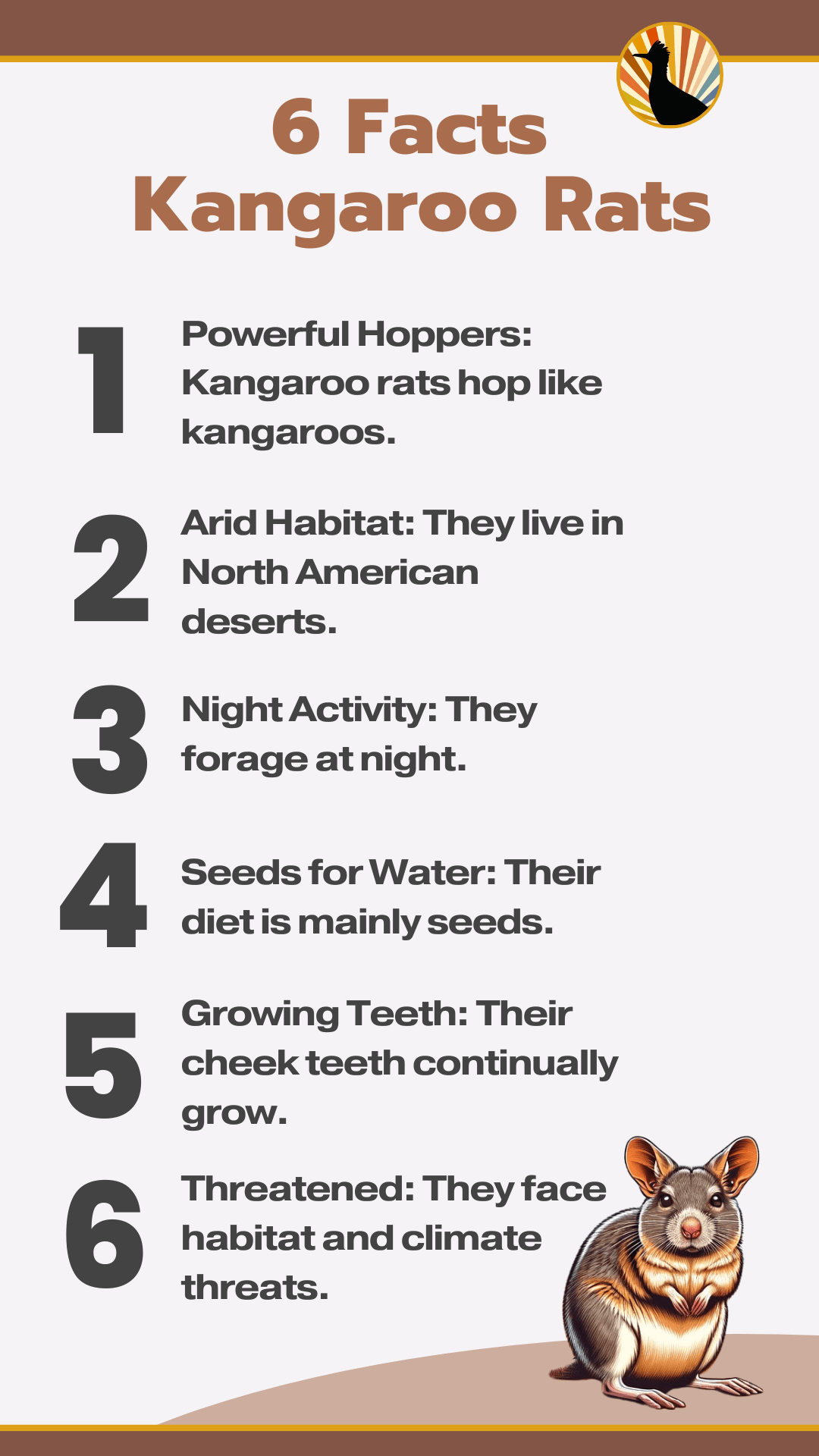
Borrego Springs, California, is a haven for diverse wildlife, including the intriguing kangaroo rat, a member of the order Rodentia and family Heteromyidae. These fascinating creatures, notably the Merriam’s and Bannertail kangaroo rats, are well-studied for their distinctive hind limb structure and hopping patterns, which inspired their name.
Kangaroo rats stand out with their long, powerful hind legs and feet, particularly their robust skull. Unique to this species, the cheek teeth of Dipodomys (kangaroo rats) continually grow, supporting their dietary needs. Additionally, kangaroo rats feature external fur-lined cheek pouches and distinct dermal sebaceous glands on their back. This blog post delves into their world, exploring their nutrition, role in research, diseases, and laboratory care, alongside their crucial role in the Borrego Springs ecosystem.
Physical Characteristics And Adaptive Behaviors Of Kangaroo Rats
Kangaroo rats are distinctive for their large hind legs that enable them to hop at speeds up to 9 miles per hour, resembling their marsupial namesakes. These adaptations are crucial for their survival in the harsh desert environment of North America. Their large eyes and ears enhance their nocturnal activities, helping them navigate the darkness. Furthermore, they are known for their bushy tails, which add to their unique appearance.

Behaviorally, kangaroo rats are primarily seed eaters, remarkably surviving long periods without water by extracting moisture from their food. They use their powerful hind legs to evade predators, exhibiting a solitary nature except during breeding.
Recent Discoveries: The Architectural Ingenuity Of Kangaroo Rats
Recent research by geotechnical engineer Idil Akin from Washington State University has shed light on an extraordinary aspect of kangaroo rats: their ability to construct durable burrows. These burrows, capable of withstanding extreme climates and flash floods, are hotspots for microbial communities. The kangaroo rats transfer these microbes via their cheeks and feet, contributing to the structural integrity of the burrows. This fascinating discovery is now being further explored to understand how these microbial communities affect the burrows’ resilience.
Vital Role In The Desert Ecosystem
Kangaroo rats are integral to the desert ecosystem as seed dispersers. They store seeds in their underground burrows, facilitating the growth of new plants and thereby sustaining the desert flora. These rodents also form a crucial part of the food chain, serving as prey for predators like snakes, birds of prey, and kit foxes.
Facing Threats: The Challenges For Kangaroo Rat Survival
In Borrego Springs and beyond, kangaroo rats confront several threats. Habitat destruction due to urbanization and agriculture, climate change altering food sources, and the introduction of non-native predators like domestic cats and ravens are significant concerns impacting their populations.
Conservation Efforts: Safeguarding The Kangaroo Rat
Conservation initiatives are crucial in protecting kangaroo rats and their habitats. The California Department of Fish and Wildlife collaborates with land managers and developers to reduce the impact on kangaroo rat populations. Notable is the translocation project by the San Diego Zoo Wildlife Alliance, which involves moving endangered kangaroo rats to conserved lands. This complex process includes personality assessments, fitting radio transmitters for tracking, and acclimation chambers at the new site.
The success of such efforts is vital for the survival of these species, as seen in the successful translocation of 38 San Bernardino kangaroo rats to a new habitat, demonstrating the potential for effective conservation strategies.
Preserving Borrego Springs’ Unique Desert Inhabitants
The kangaroo rats of Borrego Springs are not just fascinating creatures; they are essential components of the desert ecosystem. Their role in seed dispersal and as a food source for predators highlights their ecological importance. Acknowledging the threats they face and supporting conservation efforts is imperative to ensure the survival of these unique animals. By protecting kangaroo rats, we not only preserve a species but also the health and balance of the desert ecosystem they inhabit.
Here’s a list of facts about the kangaroo rat, specifically focusing on the genus Dipodomys , from the provided text:
- Taxonomic Classification : Kangaroo rats belong to the order Rodentia and family Heteromyidae.
- Common Species : The most commonly studied species are Merriam’s kangaroo rat and the Bannertail kangaroo rat.
- Physical Characteristics : They are characterized by their long and powerful hind legs and feet, particularly the skull. Unlike other members of Heteromyidae, their cheek teeth grow continuously.
- Unique Features : They possess external fur-lined cheek pouches and dermal sebaceous glands located in the intrascapular region of their back.
- Restraint and Handling : Their fragile tail should not be used for restraint. The recommended method is by grasping the loose skin at the nape of the neck.
- Blood and Urine Sampling : Blood withdrawal is best done under sedation or light anesthesia. They rarely drink water in the wild, making urine sample collection challenging.
- Auditory Specializations : They have hypertrophied middle ear cavities, with the combined volume of both ears being greater than their brain volume. This adaptation aids in low-frequency hearing, crucial for predator avoidance.
- Predation Avoidance : Kangaroo rats can avoid predatory strikes in the dark, but those with reduced middle ear volumes or impaired vision struggle to do so.
- Breeding and Reproduction : Females are seasonally polyestrous, with gestation lasting approximately 29–33 days. Litter sizes vary across species.
- Water Conservation : They are adapted to arid environments, conserving water by metabolizing food internally and concentrating urine within efficient kidneys.
- Territorial Behavior : They are highly territorial and solitary, with aggressive behavior towards intruders.
- Communication : They produce a thumping sound with hindfeet for alarm against predators and to mark territory.
- Diet in Captivity : In the laboratory, they are fed seeds and grains, supplemented with lettuce. Some may develop a diabetes insipidus-like syndrome if provided water ad libitum.
- Research Use : Kangaroo rats have been used in studies related to water conservation, physiology of the kidney, human decompression sickness, thyroxine-induced basal metabolism, osteoporosis, and neuroanatomy.
These facts provide a comprehensive overview of the kangaroo rat’s biology, behavior, and its role in scientific research.

Explore Borrego Springs, the gateway to Anza-Borrego Desert State Park. Discover its stunning landscapes, vibrant community, and sustainability-focused growth.
Sign up for our newsletter!
Sign up for our newsletter!
Sign up for our newsletter!
You're All Signed Up!
Please try again later.

